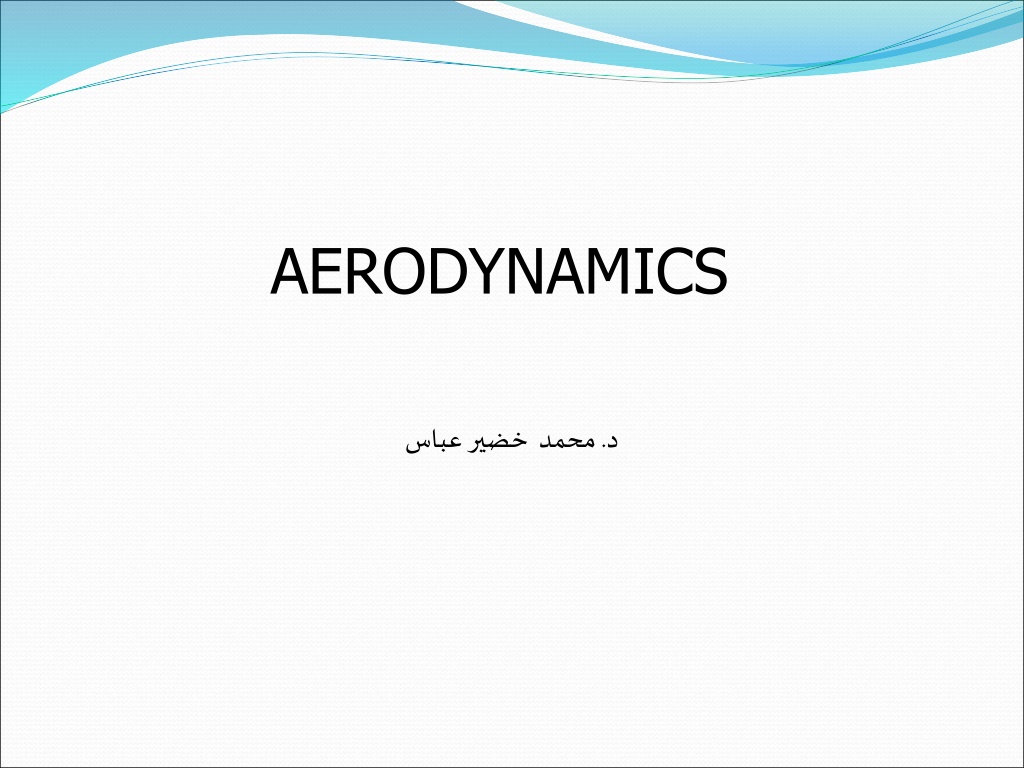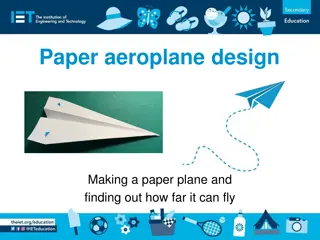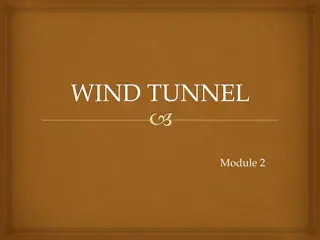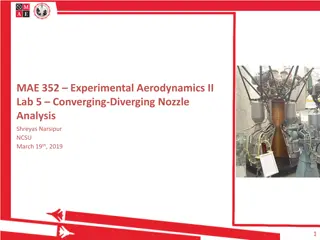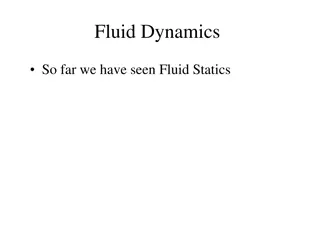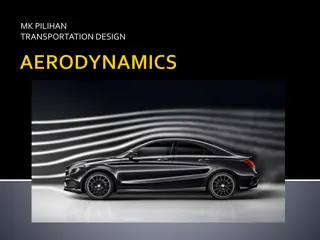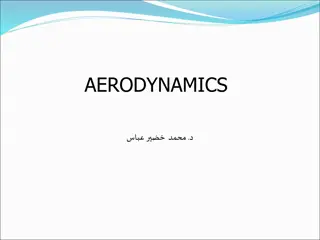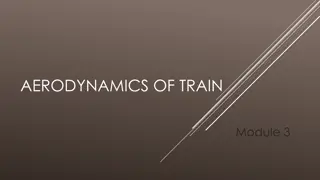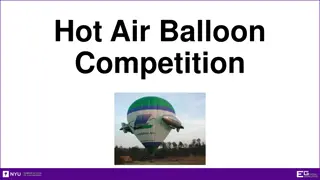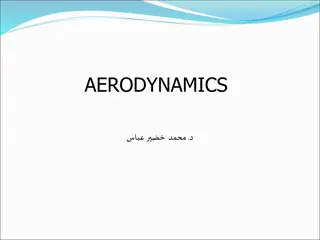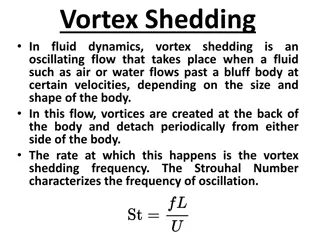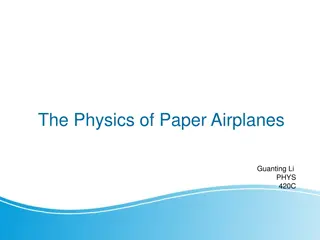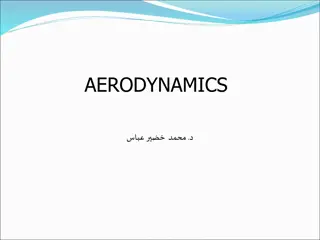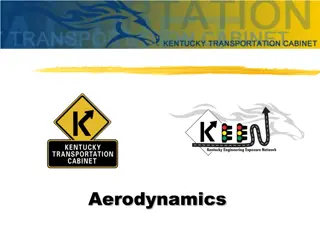AERODYNAMICS
In this study of aerodynamics, explore Bernoulli's equation, pressure coefficient, Laplace's equation, and flow principles in ducts and wind tunnels. Discover how concepts like the Venturi effect and Pitot tubes are used in measuring airflow properties. Dive into the details of velocity, pressure, and continuity in fluid dynamics to grasp the foundational aspects of inviscid and incompressible flow.
Download Presentation

Please find below an Image/Link to download the presentation.
The content on the website is provided AS IS for your information and personal use only. It may not be sold, licensed, or shared on other websites without obtaining consent from the author.If you encounter any issues during the download, it is possible that the publisher has removed the file from their server.
You are allowed to download the files provided on this website for personal or commercial use, subject to the condition that they are used lawfully. All files are the property of their respective owners.
The content on the website is provided AS IS for your information and personal use only. It may not be sold, licensed, or shared on other websites without obtaining consent from the author.
E N D
Presentation Transcript
Chap.3 Fundamentals of Inviscid, Incompressible Flow
OUTLINE Bernoulli s equation and its application Pressure coefficient Laplace s equation for irrotational, incompressible flow Elementary flows Combination of elementary flows
Bernoullis equation and its application Bernoulli s equation Relation between pressure and velocity in an inviscid, incompressible flow. Equation form along a streamline 1 2= + V p const. 2 If the flow is irrotational, 1 2= + V p const. 2 throughout the flow
Flow in a duct Continuity equation for quasi-one-dimensional flow in a duct V A V A = 1 1 1 2 2 2 For incompressible flow V A V A = 1 1 2 2
The venturi and low-speed wind tunnel In aerodynamic application, venturi can be used to measure the velocity of inlet flow V1. From Bernoulli s equation: A ( 2 ) p p = 1 2 V 1 ] 1 2 [( ) A 1 2
A low-speed wind tunnel is a large venturi where the airflow is driven by a fan. The test section flow velocity can be derived from Bernoulli s equation ( 2 2 V ) p p = 1 A 2 2 1 [ ( ) ] A 2 1
Pitto tube Stagnation point: a point in a flow where V = 0. (ex. Point B in the figure.) Stagnation pressure p0: pressure at a stagnation point, also called total pressure. To measure the flight velocity of an airplane. ( 2 ) p p = 0 1 V 1
Pressure coefficient Pressure coefficient is defined as q 1 = q p p Cp 2 V where For incompressible flow 2 Cp can be reduced to be in terms of velocity only. 2 1 V V = Cp
Laplaces equation for irrotational, incompressible flow For incompressible flow 0 = V For irrotational flow ( is velocity potential) = V Laplace s equation ( = = 2 ) 0 The stream function also satisfies Laplace s equation. 0 = 2
Solution of Laplaces equation Solutions of Laplace s equation are called harmonic functions. Superposition principle is applicable since Laplace s equation is linear. A complicated flow pattern can be synthesized by adding together a number of elementary flows.
Boundary contions Infinity boundary conditions = y x = = u V y x = = = 0 v Wall boundary conditions (wall tangency conditions) = s n = , 0 0
Elementary flows Uniform flow A uniform flow is a physically possible incompressible and irrotational flow. Boundary condition for V u x = = y = = 0 v Solution for V = x
Boundary condition for V u y = = x = = 0 v Solution for V = y
Source flow Cylindrical coordinate system is applied. Incompressible at every point except the origin. Irrotational at every point. Velocity field , 2 r = = 0 Vr V where is the source strength, defined as the volume flow rate per unit length.
is positive for a source flow, whereas negative for a sink flow. Solution for and r = ln 2 = 2
Doublet flow A pair of source-sink with the same strength, while the distance l between each other tends to zero. Stream function = l = = lim l ( ) lim l ( ) d 1 2 2 2 0 0 l = where =const. is the strength of the doublet.
Solution for and = 2 sin cos r 2 = r The direction of a doublet is designated by an arrow draw form the sink to the source.
Vortex flow A flow where all the streamlines are concentric circles, and the velocity along any circular streamline is constant. Incompressible at every point. Irrotational at every point except the origin.
Velocity field = = , 0 Vr V 2 r where is the circulation. Solution for and = 2 = ln r 2
Combination of elementary flows Superposition of a uniform flow and a source Stream function r V = + sin 2
Velocity field = Vr 1 r = + cos V 2 r r = = sin V V Stagnation point + = cos 0 V = ( , ) ( 2 , ) r V 2 r = sin 0 V = 2 The streamline goes through the stagnation point is described by = /2, shown as curve ABC .
Streamline ABC separates the fluid coming from the free stream and the fluid emanating from the source. The entire region inside ABC could be replaced with a solid body of the same shape.
Superposition of a uniform flow and a source- sink pair Stream function ( 2 = + sin ) V r 1 2
Two stagnation points A and B are found by setting V=0. The stagnation streamline is given by =0, i.e. r V = + = sin ( ) 0 1 2 2 which is the equation of an oval, called Rankine oval. The region inside the oval can be replaced by a solid body with the same shape.
Nonlifting flow over a circular cylinder Superposition of a uniform flow and a doublet Stream function 2 r R = 2 sin 1 wher , e 2 V r R V 2
Velocity field 1 r 1 2 R = = cos Vr V 2 r + 1 r 2 R = = sin V V 2 r The stagnation streamline is given by =0, i.e. 2 r R = = sin 1 0 V r 2 The stagnation streamline includes the circle described by r=R, and the entire horizontal axis through points A and B.
We can replace the flow inside the circle by a solid body. Consequently, a flow over a circular cylindrical of radius R can be synthesized by this superposition, where = V 2 R The pressure distribution is symmetric about both axes. As a result, there is no net lift, as well as no net drag which makes no sense in real world.
Define span efficiency factor e ) 1 ( e + = 1 2 L C = C , D i AR e Note that =0 and e=1 for the elliptical lift distribution. Hence, the lift distribution which yields minimum induced drag is the elliptical lift distribution.
